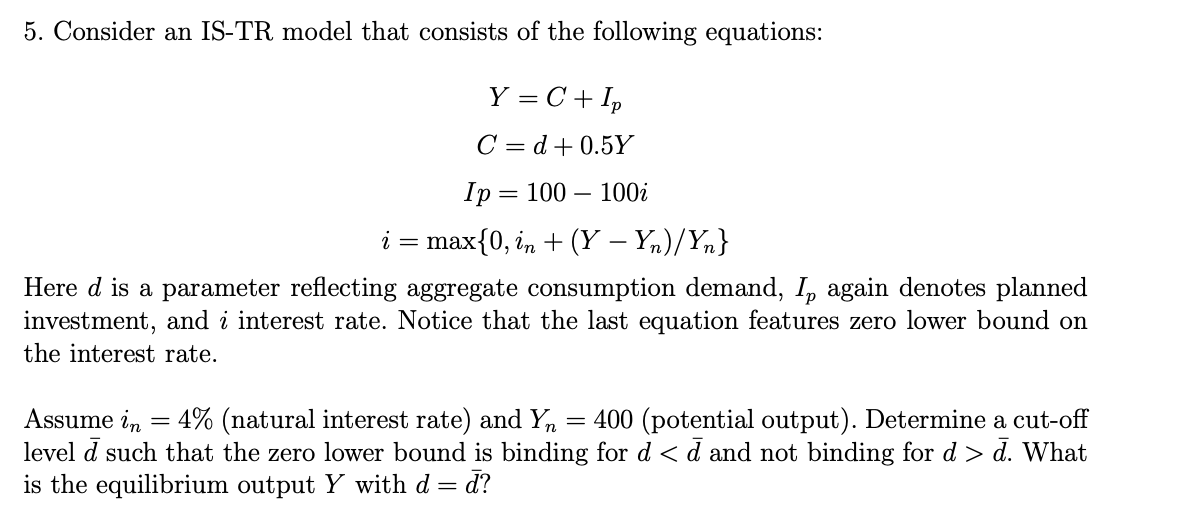5. Consider an IS-TR model that consists of the following equations: Y = C + Ip C = d+0.5Y Ip 100 100i = i = : max{0, in + (Y — Yn)/Yn} Here d is a parameter reflecting aggregate consumption demand, Ip again denotes planned investment, and i interest rate. Notice that the last equation features zero lower bound on the interest rate. 4% (natural interest rate) and Yn Assume in = 400 (potential output). Determine a cut-off level d such that the zero lower bound is binding for d < d and not binding for d > d. What is the equilibrium output Y with d = d? =
5. Consider an IS-TR model that consists of the following equations: Y = C + Ip C = d+0.5Y Ip 100 100i = i = : max{0, in + (Y — Yn)/Yn} Here d is a parameter reflecting aggregate consumption demand, Ip again denotes planned investment, and i interest rate. Notice that the last equation features zero lower bound on the interest rate. 4% (natural interest rate) and Yn Assume in = 400 (potential output). Determine a cut-off level d such that the zero lower bound is binding for d < d and not binding for d > d. What is the equilibrium output Y with d = d? =
Chapter1: Making Economics Decisions
Section: Chapter Questions
Problem 1QTC
Related questions
Question
Hi,
Could you help me solve this problem? The problem is attached as an image, as it contains characters I cannot type here.

Transcribed Image Text:5. Consider an IS-TR model that consists of the following equations:
Y = C + Ip
C = d+0.5Y
Ip
i = max {0, in + (Y−Yn)/Yn}
Here d is a parameter reflecting aggregate consumption demand, Ip again denotes planned
investment, and i interest rate. Notice that the last equation features zero lower bound on
the interest rate.
= 100 - 100i
4% (natural interest rate) and Yn
Assume in =
400 (potential output). Determine a cut-off
level d such that the zero lower bound is binding for d < d and not binding for d > d. What
is the equilibrium output Y with d = d?
=
Expert Solution
This question has been solved!
Explore an expertly crafted, step-by-step solution for a thorough understanding of key concepts.
Step by step
Solved in 3 steps

Knowledge Booster
Learn more about
Need a deep-dive on the concept behind this application? Look no further. Learn more about this topic, economics and related others by exploring similar questions and additional content below.Recommended textbooks for you


Principles of Economics (12th Edition)
Economics
ISBN:
9780134078779
Author:
Karl E. Case, Ray C. Fair, Sharon E. Oster
Publisher:
PEARSON

Engineering Economy (17th Edition)
Economics
ISBN:
9780134870069
Author:
William G. Sullivan, Elin M. Wicks, C. Patrick Koelling
Publisher:
PEARSON


Principles of Economics (12th Edition)
Economics
ISBN:
9780134078779
Author:
Karl E. Case, Ray C. Fair, Sharon E. Oster
Publisher:
PEARSON

Engineering Economy (17th Edition)
Economics
ISBN:
9780134870069
Author:
William G. Sullivan, Elin M. Wicks, C. Patrick Koelling
Publisher:
PEARSON

Principles of Economics (MindTap Course List)
Economics
ISBN:
9781305585126
Author:
N. Gregory Mankiw
Publisher:
Cengage Learning

Managerial Economics: A Problem Solving Approach
Economics
ISBN:
9781337106665
Author:
Luke M. Froeb, Brian T. McCann, Michael R. Ward, Mike Shor
Publisher:
Cengage Learning

Managerial Economics & Business Strategy (Mcgraw-…
Economics
ISBN:
9781259290619
Author:
Michael Baye, Jeff Prince
Publisher:
McGraw-Hill Education